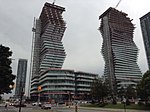Square One Shopping Centre

Square One Shopping Centre, or simply Square One, is a shopping mall located in Mississauga, Ontario, Canada. It is the largest shopping centre in Ontario and the second largest shopping centre in Canada, after the West Edmonton Mall. It has over 2,200,000 square feet (200,000 m2) of retail space, with more than 360 stores and services. On average, the mall serves over 24 million customers each year. The shopping centre also has many condominiums near it.Square One is located in downtown Mississauga adjacent to the interchange of Highway 403 and Hurontario Street, near the Mississauga Civic Centre, the Mississauga Living Arts Centre and the Mississauga Central Library. Located within the mall grounds is the main terminal of MiWay (formerly Mississauga Transit) bus network, which opened in 1997, and a Peel Regional Police station, which opened in 2002.
Excerpt from the Wikipedia article Square One Shopping Centre (License: CC BY-SA 3.0, Authors, Images).Square One Shopping Centre
City Centre Drive, Mississauga
Geographical coordinates (GPS) Address Website External links Nearby Places Show on map
Geographical coordinates (GPS)
| Latitude | Longitude |
|---|---|
| N 43.593055555556 ° | E -79.642777777778 ° |
Address
Square One
City Centre Drive 100
L5B 2N5 Mississauga
Ontario, Canada
Open on Google Maps









